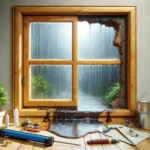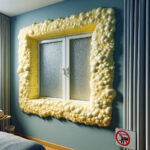In the face of harsh weather, wooden windows can sometimes let water through, causing potentially serious damage to the integrity of a home. As an article in
La Presse indicates, although polyurethane foam is an excellent insulator against air and water, it is essential to know the best practices to guarantee the waterproofing of wooden windows. This guide will explore the most effective methods to combat water infiltration through wooden windows, providing long-lasting and aesthetically pleasing solutions.
By looking at the causes and consequences of water infiltration, this article will provide practical recommendations for improving the airtightness of your windows. Whether you’re a novice DIYer or an experienced professional, you’ll find relevant tips for protecting your home here.
Understanding Water Infiltration
Wooden windows are often chosen for their natural beauty and ability to thermally insulate. However, without proper maintenance, they can be prone to water infiltration. These infiltrations usually occur due to aging joints, degraded wood, or the lack of an effective waterproof barrier. Water entering through these gaps can cause significant structural damage, such as wood rot and mould, which can affect indoor air quality and the health of residents.
Preventive and Reactive Solutions
Regular Inspection and Maintenance
The first step to preventing water ingress is to conduct regular inspections. Look for signs of deterioration such as swollen wood, peeling paint, or cracked joints. Treating these problems as soon as they appear can prevent water from seeping in and causing more damage.
Sealing and Caulking
Using the right caulking products is crucial for wooden windows. Choosing the right type of sealant, which should be flexible, water-resistant, and wood-compatible, will create a watertight barrier. The application should be done meticulously, making sure that all cracks and joints are properly sealed.
Wood Treatments
Treating wood with water-repellent products or specific stains can also play a significant role in preventing water infiltration. These treatments help repel water and protect the wood from the elements, extending the life of your windows.
Installing New Windows
In some cases, when windows are too damaged to repair, they may need to be replaced. Opting for modern windows with treated wood frames or hybrid windows (wood on the inside, aluminum or PVC on the outside) can offer a long-lasting solution against water infiltration.
Explanatory table of solutions
To make your decision easier, here is a table summarizing the different solutions, their advantages and disadvantages:
| Solution |
Description |
Benefits |
Disadvantages |
| Regular inspection |
Periodic checking of windows for signs of deterioration or damage to the wood. |
Allows for early detection of problems, easy to do. |
Requires frequent inspections. |
| Caulking and sealing |
Application of sealants around window frames. |
Creates a barrier against water, extends the life of windows. |
Must be redone periodically. |
| Wood treatment |
Application of water repellents or stains to the wood. |
Protects against moisture, prevents rot. |
May require professional application. |
| Replacing windows |
Installation of new, more water-resistant windows. |
Long-term solution, improves insulation. |
High cost, more complex installation. |
Protecting Your Home Effectively
By following these steps, you can significantly reduce the risk of water infiltration through your wooden windows and ensure the durability and safety of your home. The investment in maintenance and possibly replacement of windows may seem substantial, but it is justified by the long-term savings in terms of costly repairs and avoided damage. Thus, properly maintained, your wooden windows will continue to beautify your home while effectively protecting it from the outside elements.



